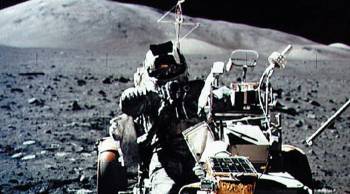C-130 aircraft designed in the 1950s still delivers
When Lockheed designed the C-130 Hercules in the 1950s, a company engineer, Kelly Johnson, said they’d be lucky to sell a hundred. Out on the tarmac in Marietta, Georgia, Lockheed Martin’s Tony Frese, vice president and deputy program manager of C-130 Programs, is delivering No. 2,500.
Photo from 1955 shows the C-130A.
“Here we are, 60 years later,” said Frese. “So we always are quite thankful that Kelly Johnson, a brilliant man, got that one piece wrong.”
Johnson was working on sleek reconnaissance jets. The Hercules, by comparison, is clunky, with large propellers, a heavy tail and a belly big enough to fit a bulldozer.
But that’s been the massive transport plane’s secret to long life. In fact, at 60 years, the C-130 Hercules is the longest continuously produced military aircraft.
Richard Aboulafia studies aviation trends for the Teal Group and his analogy for the C-130 is a Coelacanth, a sea creature that escaped extinction.
“That ancient fish that was hauled up and, well, there it is, still alive,” Aboulafia said. “And it’s alive for all the right reasons — it’s really good at what it does.”
What the C-130 does, simply, is cart things or people around for the military, so it’s used for a wide range of purposes, including special operations, humanitarian relief, and search and rescue missions. It can refuel other aircraft in flight. Sometimes a C-130 does coastal patrol.
The Marietta, Georgia, Lockheed Martin plant, where the C-130 Hercules has been assembled for the past 60 years. (Courtesy of Lockheed Martin)
“Basically, it’s a terrific jack-of-all-trades,” said Aboulafia. “And since its success isn’t based upon some kind of high-tech, whiz-bang performance, like stealth or speed or anything like that, that basic design from the ’50s is still quite relevant today.”
Most military aircraft programs last 20 to 30 years before losing ground to new technology. With the Hercules, Lockheed Martin can just add technology to the same proven plane. While the price can vary, the basic version of the latest model costs something in the realm of $70 million.
Sixty years of production at the same facility means entire families in Marietta have been tied to the aircraft.
Members of the crew on the on the tarmac.
At the C-130 plant, Kim Gunter is helping build the latest Hercules. His father worked on the very first.
“We’ve been on every one of the them,” said Gunter. “So … it is a neat plane, a cool plane and I’m glad to be here working on it.”
Back when Lockheed assembled multiple aircrafts in Marietta, the facility had 33,000 employees. Now there are fewer than 6,000, who mainly work on the C-130 program. Living here, Gunter said he’s seen the benefits.
“The best thing that ever happened to Marietta was that C-130 coming over here and being built here,” Gunter said. “You know, it’s good times, bad times, with orders and stuff like that. But we keep selling them.”
They keep selling them, because the U.S. military relies on them on a daily basis, said Todd Harrison, director of defense budget analysis at the Center for Strategic and International Studies. The Hercules, Harrison pointed out, has remained in production not only during conflicts going back to the Vietnam War, but after them.
“And so this program has really seen the ups and downs of the budget cycle over the decades,” Harrison said. “And nevertheless it has survived. And if you look at current plans right now, we’ll continue buying C-130s out through the late 2020s.”
As for the 2,500th Hercules aircraft that took off from Marietta, it was sold to the U.S. Air Force. And it too could end up anywhere in the world, depending on where there’s a need.
There’s a lot happening in the world. Through it all, Marketplace is here for you.
You rely on Marketplace to break down the world’s events and tell you how it affects you in a fact-based, approachable way. We rely on your financial support to keep making that possible.
Your donation today powers the independent journalism that you rely on. For just $5/month, you can help sustain Marketplace so we can keep reporting on the things that matter to you.


















